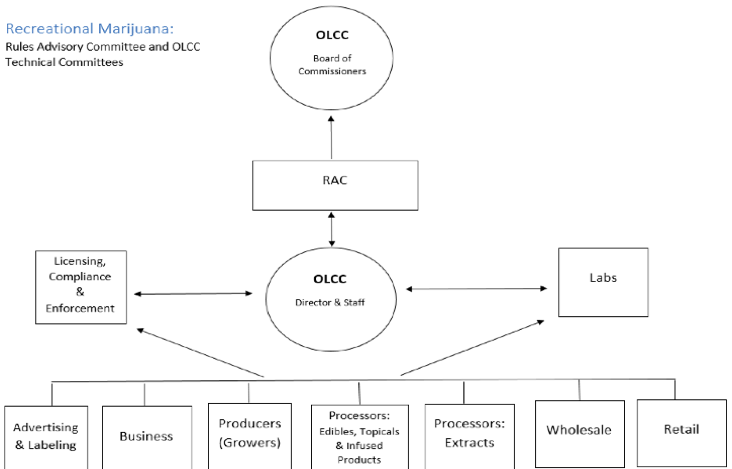On October 1st, 2015, the Oregon Recreational Market went live on a restricted basis, permitting only select medical marijuana facilities to operate until 2016.[1] However, it was not until mid-October that official draft rules were signed into law. These draft rules implemented several proposed rules, and changed others. Oregon’s recreational Marijuana market illustrates the difficulties of designing a market through legal and policy frameworks. Competing interests must be balanced, and often, these interests are superseded by the opinions of regulators themselves. The success (or failure) of Oregon’s recreational market will likely impact development of recreational marijuana policy nationwide. As the Oregon Liquor Control Commission (OLCC) and the country learn more about the markets, policies and regulations will adapt to each new development. The power to regulate the recreational marijuana industry was delegated to the OLCC by the Oregon legislature, and the results of the OLCC’s long deliberations are a mixed bag of protectionism, public safety, and free market ideas. Research on medical marijuana is difficult to perform because of cannabis’s status as a Schedule I substance. As a result, the OLCC was engaging in a new frontier of policy. For now, Oregon has managed to balance regulations for a market for unknown and little-researched goods with policies that ensure quality and work with companies that wish to participate in the market.
The process undertaken in Oregon reveals that legalizing marijuana is a task far more complex than simply taxing it and making the substance legal for possession and consumption. The interplay of the private sector and public sector visible during the OLCC technical committee meetings vividly portray the challenges regulators will face in the future.
Designing a Market: Oregon’s Approach
Figure 1 illustrates the regulatory structure devised for the crafting of the regulations that will form the framework for this market. At the top, implementing the policy and enacting the regulations, is the Board of Commissioners itself. The Commission receives and deliberates on the recommendations of the second tier, comprised of the Rules Advisory Committee (RAC). The RAC committee dictates policy handed down from the Board of Commissioners to the OLCC Director and employees, while receiving input from the Licensing, Compliance, and Enforcement Committee (hereafter referred to as Licensing committee) and the Labs Committee. The OLCC Director, Licensing committee, and Labs committee form Tier 3. Both the Labs committee and Licensing committee receive input from the technical committees in Tier 4. The technical committees are not permanent committees, and several have run their course already and submitted their recommendations, hence the Tier 4 ranking. [2]

Figure 1: Hierarchy of the OLCC Recreational Marijuana Regulatory Authority
The role of the technical committees was to obtain input on how to craft the regulatory framework of the market from members of the industry and other experts and make recommendations to the OLCC Board. However, because the RAC and the Board of Commissioners have the final say, discrepancies often arose between the technical committee recommendations and the realized draft rules. This illustrates one facet of the challenge of the balancing act regarding interests. The technical committees are subject to the desires of the industry to a far greater extent than the RAC committee. Members of the industries participated directly in the technical committee proposal process. However, as will be discussed below, some of their recommendations were ignored in favor of recommendations from other technical committees, and in the instances where interests clashed, the Board and RAC had the deciding votes.
The Draft Rules
A contentious issue during the deliberation process was how to structure regulations regarding applicants for licenses to operate marijuana businesses in Oregon. Concern was raised over the ability of large corporations to sweep into the market and crowd out local dispensaries and growing operations. Protectionism was not a popular option with everyone, and many hours were spent discussing how to strike a balance between a free market and the promotion of Oregonian interests.[3] The draft rules solved the issue by adding a two-year residency requirement for license applicants and a requirement that all members having at least a 10% stake in a corporation must add their names to the license application. [4]
Growers enjoy a crucial privilege: the ability to grow their product with multiple different cultivation methods on the same premises (i.e. both indoor and outdoor facilities) under one license. Growing limits take the form of ratios for canopy size (outdoor:indoor, measured in square feet), in addition to a two-tiered licensing structure distinguishing small-scale operations from larger ones. [5] Their freedom to grow their product in multiple formats on the same premises is balanced with restrictions on the acquisition of inventory, with prohibitions on inventory obtained from outside Oregon and inventory obtained from anyone other than another licensee. Growers must also log all pesticides, fertilizers, or other agricultural chemicals used in the production of marijuana, as well as the batch to which these chemicals were applied, and maintain these logs electronically or in hard copy for at least two years post-harvest. Security plans must be submitted with the license application. [6] Retailers face fewer, but no less important restrictions. The quantity permitted to be sold to an individual consumers with each purchase is regulated, along with hours of operation. Finally, retailers are required to distribute informational material on marijuana with every sale.[7]
Processors of Extracts and Edibles face much more stringent regulations. Specifically, unless a processor is endorsed for a given product by the OLCC, production or retail sale of that product is prohibited. Criteria for endorsement include a description of both the product and the equipment used to create the extracts or concentrates. Processors may hold multiple endorsements under one license, and must notify the OLCC upon ceasing production of an endorsed product. Processors are also required to take part in the central tracking system required by the legislature, and are forbidden from selling or processing products that are “likely to appeal to minors”[8]. Processors wishing to produce edible products are forbidden from operating in any kind of restaurant or sharing a premises with commercial food producers or producers of goods without cannabinoids, and they may not share their establishment with entities not licensed and endorsed as edible processors by the OLCC. The draft rules are extensive, including restrictions on packaging, labeling, and testing procedures among others. However, the chief concerns here lie with regulations previously discussed.[9]
Implications and Conclusion
The draft rules are more restrictive than the industry desired. On multiple issues, industry interests were ignored in favor of public safety or other interests. One such instance was the prohibition of processors operating in shared kitchens. The industry members on the technical committee lobbied hard for the ability to operate shared kitchens, and the committee itself recommended measures to ensure safety and protection of intellectual property, while remaining split on the issue. [10] However, it would appear the RAC or Board did not share the views of the committee. Though standards for security measures were largely uniform across technical subcommittees, the standards for production and the restrictions regulating processors and retailers place increased capital and financial burdens on new entrants to the market. At the same time, growers are allowed significant freedom when it comes to their facilities in the form of permission to hold multiple licenses for the same premises. A few regulations are likely to draw the industry’s ire because the industry does not feel that its products warrant such restrictions. Regulations regarding marketing towards children and childproof containers, for example, were contentious during the technical committee debates.[11]
In the end, the market that has been constructed has become less free and more regulated than the industry hoped. At the same time, regulations are less restrictive than at the federal level. This is both beneficial and detrimental to the industry, as the existence of the market affords them a place to operate with a large degree of freedom until the national market begins to take shape. At such time, oversight agencies such as the FDA are likely to implement requirements that supersede state regulations will be established. Regulations regarding testing and disposal of failed product could reflect this difference, as only products that fail pesticide testing are disposed of. Products that fail microbiological or solvents testing may be reprocessed until they pass. When national regulations are enacted, it is conceivable that these particular regulations will not stand, depending on the views of the FDA, DEA, and USP on the issue. What makes the Oregon market attractive is their licensing requirements. A delicate balance is afforded by requiring a two-year residency for license applicants while also requiring members of a corporation with a certain stake in the company to disclose that stake by registering as a licensee. Dispensaries under Oregon’s medical market had abused a similar system. “Persons responsible for facility” were the license applicants, yet often they had no real power over the company’s actions.[12] Oregon’s solution is restrictive, but not so restrictive as to completely discourage investment.
The Oregon Market is therefore simultaneously protectionist and free market. Growers’ control over their product is largely left intact, and the flexibility afforded by allowing multiple growing facilities on the same licensed premises cannot be overstated. While processors face some initially restrictive regulations, the ability to hold multiple endorsements under one license somewhat offsets the barrier of having to acquire the endorsement in the first place. Yet, not all the proposed regulations were implemented by the RAC or Board of Commissioners. Informational materials requirements and restrictions on marketing provide examples of the other side of the balancing act. When placed in the context of Federal regulations, Oregon’s regulators have crafted a market which affords room for growth and development. The process also sheds light on the difficulty of legalizing a product such as marijuana. With the issue looming as part of the presidential elections this year, candidates are being examined closely on issues like the legalization of marijuana. The simple reality is that legalization will require far more than simply adjusting the legal codes and establishing a tax rate. Oregon and states like it are at the forefront of this policy issue, paving the way for the Federal Government to establish tried and true regulations in the future.
- Gosia Wozniacka, “Oregon Pot Shops prep for Oct. 1 debut of recreational sales.” The Cannabist, http://www.thecannabist.co/2015/09/28/oregon-dispensaries-recreational-marijuana-sales-oct-1/41549/. Accessed 11/27/2015 ↑
- OLCC. “Marijuana Rules Advisory Committee and Technical Subcommittees.” Oregon Liquor Control Commission. http://www.oregon.gov/olcc/marijuana/Documents/Marijuana_Rules_Advisory_Committee_org.pdf ↑
- OLCC Licensing, Compliance, and Enforcement Technical Committee. 7/2/2015. http://olcc.suiteonemedia.com/Web/Player.aspx?id=63&key=-1&mod=-1&mk=-1&nov=0 ↑
- Oregon Liquor Control Commission. Recreational Marijuana. 845-025-1000 thru 845-025-8580. http://www.oregon.gov/olcc/marijuana/Documents/TemporaryMarijuanaRules_adopted_112015.pdf ↑
- Ibid. ↑
- Ibid. ↑
- Ibid. ↑
- Ibid, 845-025-3220 (p. 37) ↑
- Ibid. ↑
- OLCC Edibles, Topicals, and Infused Products Technical Committee. 6/24/2015. “June 24th 2015 Meeting Summary and Recommendations.” Oregon Liquor Control Commission. http://www.oregon.gov/olcc/marijuana/Documents/Agendas/EdiblesTopicalsInfusedProducts_SummaryandRecommendations_DRAFT_062415.pdf ↑
- Ibid. ↑
- OLCC Licensing, Compliance, and Enforcement Technical Committee. 7/2/2015. http://olcc.suiteonemedia.com/Web/Player.aspx?id=63&key=-1&mod=-1&mk=-1&nov=0 ↑





